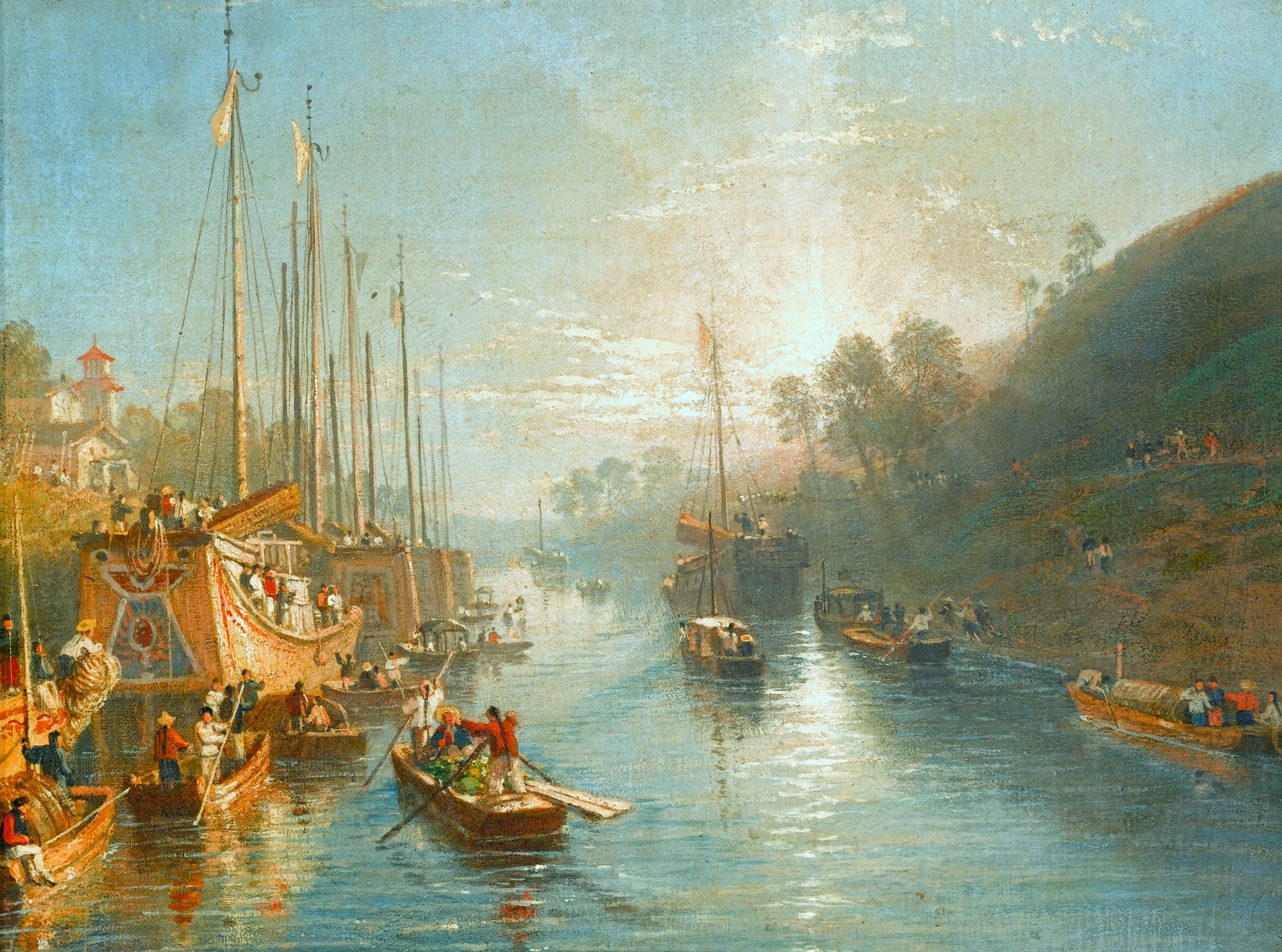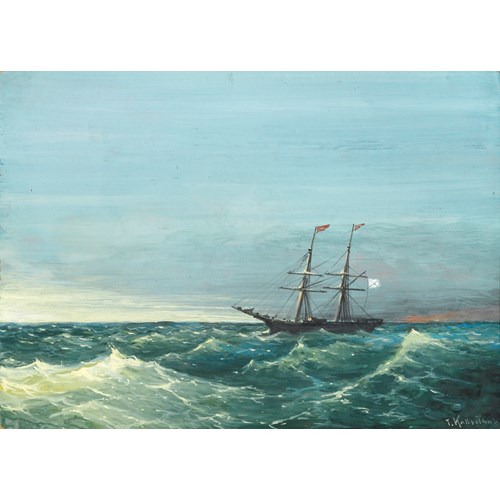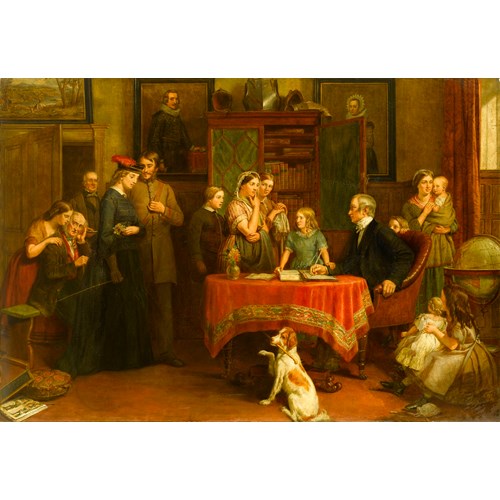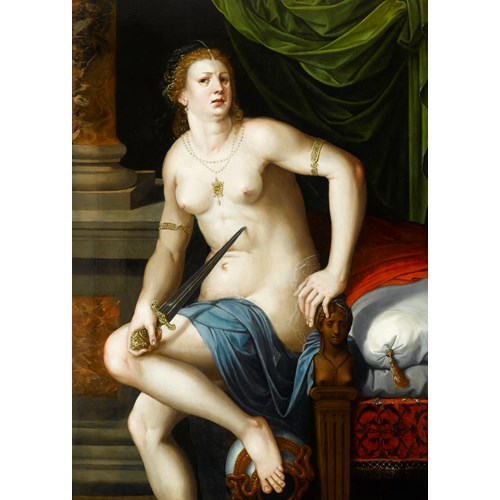Marketplace
Sunrise on the Grand Canal of China
William Havell
Sunrise on the Grand Canal of China
Epoque 1750-1850, 19th century
Origine England
Medium Oil on canvas
Dimension 33 x 41 cm (13 x 16¹/₈ inches)
The sun is rising on the ancient and grand waterway of China, the light is piercing through the distant trees and casting long shadows across the water and its industrious traders. The masts of the huge canal junks sway together on the calm water its ripples sparkling under the bright sunshine, while the local boatmen, distinguished by their long plaited dark hair and straw hats, busy themselves preparing for a new day of travel.
Havell accepted the post of official artist to the embassy of China led by William Pitt, Earl Amherst of Arracan (1773-1857) to the Chinese Emperor Jiaqing (1760-1820), which set out in 1816. The purpose of the mission was to address ‘the complaints of injustice and exactions on the part of the Chinese mandarins . . . from the English merchants at Canton’, although the journey ultimately proved futile when Lord Amherst, refused to kowtow to the emperor. Although it is unclear whether Havell accompanied Amherst to Peking or remained with the ships at the Grand Canal of the Hai river near Tongzhou, he was able to sketch the Chinese countryside on the return route overland. Little of his Chinese work came to be seen, with just a handful of images credited to the artist in the various acccounts which followed. The penultimate paragraph in the advertisement for Henry Ellis’ Journal of the Proceedings of the late Embassy to China reads ‘Had the author’s intention been known, or indeed had it existed at Canton, the value of the work would probably have been increased by some efforts of Mr. Havell’s pencil; these will now, however, be reserved for a separate publication’.¹ This separate publication seems never to have appeared. In fact, the only original ‘efforts of Mr. Havell’s pencil’ to be used on any matter in connection with the Embassy seem to be plate number 1 (Exocoetus Splendens) in Clarke Abel’s (c. 1789-1826) Narrative of a Journey in the Interior of China, and plates numbers 2, 5, 6, and 8 in Captain Basil Hall’s (1788-1844) Account of a Voyage of Discovery to the West Coast of Corea. The Preface to Hall’s book seems to imply that even these latter five plates are not after Havell, but the signatures on the plates give them as his.
Havell left the ship owing to a quarrel with one of the officers, and ‘having gravely offended one of them and refused him the satisfaction demanded, his position was rendered exceedingly unpleasant’.² It seems that he stayed behind in Canton in 1817, after the rest of the mission had left there. He then spent the next eight years in India painting portraits and landscapes in watercolour.
The present subject appears to relate to Anchorage at Tong-Chow, (National Maritime Museum) one of the plates credited to Charles Abbot which illustrated Ellis’ book. Havell completed several versions of the Grand Canal. In 1827, he exhibited A View on the Grand Canal near Chong-Trieu, with the principal junks and boats employed to convey His Excellency Lord Amherst, Ambassador to the Court of China, in the year 1816 (no.192). In the same year, he showed Sunrise - Entrance to the Grand Canal with the Junks employed in the late Embassy to China (no.80) at the Royal Watercolour Society. In the following year, he exhibited View of the Grand Canal, near Changtsieu, China (no.284) at the Royal Society of British Artists.
Havell was the son of a drawing master from Reading, and he participated in several sketching societies in the early nineteenth century. After showing an early interest in the medium of watercolours, he began to establish himself as an oil painter in the manner of Richard Wilson and J.M.W. Turner, and he exhibited works at the Royal Academy and the British Institution. Having travelled to China he moved to India and Ceylon (now Sri Lanka), where he spent six years painting portraits and landscapes before returning to England in 1826. In 1828 he travelled to Italy, returning a year later, subsequently he remained in England, exhibiting vivid landscapes. In the late 1830s Havell, together with his brother Frederick James, experimented with ‘photogeny’ and incurred the hostile rivalry of Henry Fox Talbot, the pioneering inventor of modern photography. He died in London in 1857, after years of poor health but his work has remained highly regarded, ‘remarkable for good composition and often for the effect of sunshine’.³
¹ Ellis, H., Journal of the Proceedings of the Late Embassy to China (John Murray, London, 1817), p.iv.
² Redgrave, R. & Redgrave, S., A Century of Painters of the English School (Smith, Elder and co., London, 1866), p. 520.
³ James, R., Painters and their Works, vol. 1 (L. Upcott Gill, London, 1896), p.521.
Havell accepted the post of official artist to the embassy of China led by William Pitt, Earl Amherst of Arracan (1773-1857) to the Chinese Emperor Jiaqing (1760-1820), which set out in 1816. The purpose of the mission was to address ‘the complaints of injustice and exactions on the part of the Chinese mandarins . . . from the English merchants at Canton’, although the journey ultimately proved futile when Lord Amherst, refused to kowtow to the emperor. Although it is unclear whether Havell accompanied Amherst to Peking or remained with the ships at the Grand Canal of the Hai river near Tongzhou, he was able to sketch the Chinese countryside on the return route overland. Little of his Chinese work came to be seen, with just a handful of images credited to the artist in the various acccounts which followed. The penultimate paragraph in the advertisement for Henry Ellis’ Journal of the Proceedings of the late Embassy to China reads ‘Had the author’s intention been known, or indeed had it existed at Canton, the value of the work would probably have been increased by some efforts of Mr. Havell’s pencil; these will now, however, be reserved for a separate publication’.¹ This separate publication seems never to have appeared. In fact, the only original ‘efforts of Mr. Havell’s pencil’ to be used on any matter in connection with the Embassy seem to be plate number 1 (Exocoetus Splendens) in Clarke Abel’s (c. 1789-1826) Narrative of a Journey in the Interior of China, and plates numbers 2, 5, 6, and 8 in Captain Basil Hall’s (1788-1844) Account of a Voyage of Discovery to the West Coast of Corea. The Preface to Hall’s book seems to imply that even these latter five plates are not after Havell, but the signatures on the plates give them as his.
Havell left the ship owing to a quarrel with one of the officers, and ‘having gravely offended one of them and refused him the satisfaction demanded, his position was rendered exceedingly unpleasant’.² It seems that he stayed behind in Canton in 1817, after the rest of the mission had left there. He then spent the next eight years in India painting portraits and landscapes in watercolour.
The present subject appears to relate to Anchorage at Tong-Chow, (National Maritime Museum) one of the plates credited to Charles Abbot which illustrated Ellis’ book. Havell completed several versions of the Grand Canal. In 1827, he exhibited A View on the Grand Canal near Chong-Trieu, with the principal junks and boats employed to convey His Excellency Lord Amherst, Ambassador to the Court of China, in the year 1816 (no.192). In the same year, he showed Sunrise - Entrance to the Grand Canal with the Junks employed in the late Embassy to China (no.80) at the Royal Watercolour Society. In the following year, he exhibited View of the Grand Canal, near Changtsieu, China (no.284) at the Royal Society of British Artists.
Havell was the son of a drawing master from Reading, and he participated in several sketching societies in the early nineteenth century. After showing an early interest in the medium of watercolours, he began to establish himself as an oil painter in the manner of Richard Wilson and J.M.W. Turner, and he exhibited works at the Royal Academy and the British Institution. Having travelled to China he moved to India and Ceylon (now Sri Lanka), where he spent six years painting portraits and landscapes before returning to England in 1826. In 1828 he travelled to Italy, returning a year later, subsequently he remained in England, exhibiting vivid landscapes. In the late 1830s Havell, together with his brother Frederick James, experimented with ‘photogeny’ and incurred the hostile rivalry of Henry Fox Talbot, the pioneering inventor of modern photography. He died in London in 1857, after years of poor health but his work has remained highly regarded, ‘remarkable for good composition and often for the effect of sunshine’.³
¹ Ellis, H., Journal of the Proceedings of the Late Embassy to China (John Murray, London, 1817), p.iv.
² Redgrave, R. & Redgrave, S., A Century of Painters of the English School (Smith, Elder and co., London, 1866), p. 520.
³ James, R., Painters and their Works, vol. 1 (L. Upcott Gill, London, 1896), p.521.
Epoque: 1750-1850, 19th century
Origine: England
Medium: Oil on canvas
Signature: Inscribed ‘Chinese Canal/W. Havell/No 1’ on the stretcher.
Dimension: 33 x 41 cm (13 x 16¹/₈ inches)
Plus d'œuvres d'art de la Galerie









